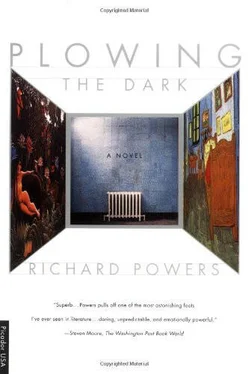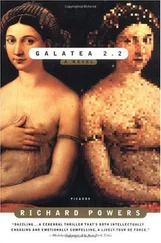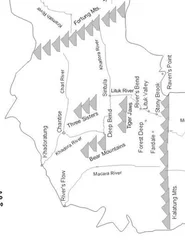Spiegel hacked several quick expressions into a terminal. The points of a curve percolated up from out of the algebraic shorthand. He sliced off a conic section and roughed up its edges. He wrote out a well-behaved polynomial to describe the range and rise and run. The X of the thing, the willing Y, the demure Z.
Frame buffers then threw his results upon a screen for the design group to witness. Artists and engineers drifted through the room as Steve's shapes spun in space. Each time his right pinkie hit the Enter key, the screen turned into a luscious spirograph, pouring forth a
petaled profusion.
Lunettes, Michael Vulgamott, the architect, called. Spandrels. Tracery. Adie heard, in the man's voice, a fellow displaced Gothamite. Vulgamott's manic, twitching fingers ticked off the terms as if he were stepping into a crowded midtown intersection to hail a thesaurus.
The words he used made the mathematician Ari Kaladjian's bushy eyebrows balkanize. They're properly called cardioids and tricuspids and folia. Limagon of Pascal. Plane algebraic geometry has been making these curves for at least two hundred years. Kaladjian had fled the globe's chaos for the safety of mathematics, and he did not care to surrender his sanctuary to fuzzy-mindedness.
Spiegel quit his keyboard jabbing long enough to shrug. Call them what you want. They're graphics primitives. All art is Euclid's baby.
I can think of at least a couple of dubious paternity suits, Adie said.
I love my wife, Sue Loque stage-whispered. But oh, Euclid!
What's the point of starting with equations? Vulgamott wanted to know. What do we gain?
Kaladjian grunted. Everything starts with equations. Spiegel spoke with the distraction of the engrossed encoder. Plane curves are the fastest, easiest artifacts in the world to implement. And you can make trillions of them with just a few iterated expressions.
Streams in the desert? Adie mocked. Orchards from out of the arid places?
Something like that. Yes. Spiegel smiled at her, immune to her aggression. Knowing it, of old.
She frowned at his geometric petals. But where's the leaf? I see nothing that even faintly resembles the Rousseau I showed you. At best, they look like victims of a hit-and-run Calder mobile.
That's what you lose when you generate leaves by algorithm. Everything's a trade-off. In this case, you trade off natural complexity for something that's easier and faster… and much too geometrical. Much too perfect.
Too perfect! Kaladjian shouted. You cannot get too perfect. Where are the shadows and gradations? Adie sounded betrayed.
We'd have to add them. Spiegel demonstrated. A few calls to a shading routine produced a rough, pencil-sketched idea of surface.
Huh, Adie said, as the cardioid went crosshatched. Huh. That puts us about three baby steps toward a Miro. Wait! Go back a little bit. There. Try the feathered edges with the Bonnard orange.
Numbers and art both fell silent at how quickly Spiegel pulled a crepe carnation out of code's silk hat.
A pout stole over Adie's face. She extended her arm to slow things down, one palm out to break her fall.
You're trying to tell me that… math… is enough to get fake leaves to look real?
Math, Kaladjian snarled, is enough to get real leaves to look real.
Spiegel defended her. I don't think that's what she means.
What the hell does she mean, then? Kaladjian flicked one hand through the air, a disgusted scythe.
Spiegel turned to Adie. Well, she? What the hell do you mean?
God only knows. I was hoping someone here could tell me. I mean: are these equations — these cosine things — inside real plants?
Kaladjian's Of course rammed in midair into Spiegel's Not really.
The younger man, from the younger discipline, demurred. Well. That all depends on what you mean by "inside." Something in Spiegel's tone implied that no massively parallel array of processors short of the planet itself could hope to extract the perfect equation from out of imperfection's green.
Let's see some veins, Karl Ebesen said. He scrutinized the test leaves from the graphic designer's eye view. How about a few burns and insect bites? The ragged scars that silk imitations never bother to imitate.
Spiegel pressed on, coating the synthetic surface with ever-finer nubs and nuances. Boosting realism required forgoing simple polynomials and embracing a runaway explosion of polygons. Here, he told his charges, pointing at the color plate of the original jungle. Here: trying to keep his finger a safe distance from that woman's chalk-white breasts. Here, this cluster of…
Figs, Adie offered. Figs, I think.
That's supposed to be a fig tree? That? OK. Let s say fig. We turn this cluster of fig leaves into a thousand little trapezoids We manufacture every one of its kinks and blips out of tiny triangles, tilted to lie in every plane that interests us.
What they call a wire frame? Vulgamott, in his former life as an architect, had worked with endless screen-based blueprints — pale Pei imitation monoliths exploded into more tiny CAD corbels than a person could shake a French curve at.
Wire frame. Skeleton. Whatever. Groups of graph primitives: triangles, polygons. Hidden-line removal creates the sense of three-space. Lots more verisimilitude. But tons slower. Tons harder to draw.
Adie cleared her throat. Drawing shouldn't be a problem. I thought that's why we clueless Bohemians are on the payroll.
Oh, not harder for you. I meant harder for the graphics boxes. For… Rembrandt and Claude and Hsieh Ho. Ten video channels, in real time. Were talking real rendering overhead. Every object that we want to paint is an entire community. A whole ecosystem of polygons for each light-face. The better you want it, the smaller your polygons have to get, until your complex object is nothing but vertices. Hundreds of thousands of vertices, smack up against what the hard-cores call your polygon budget.
Couldn’t we just go out and shoot 360 degrees of film around some actual leaf?
Could. But youd still want to translate the picture back into data points. And youd have to do that by hand, or something like it.
Why? Adie asked. Why turn a continuous image of the real thing back into jagged little chunks?
Because, Spiegel began, running the logic through his own internal simulation, like sunlight through foliage. Because well want to give your leaf real qualities. Behaviors. Well want to run operations against it. To subject it to gravity, fire, wind. A photo of a leaf wont ooze when cut. We want a clone that will do everything the original does. Catch rain or shrivel up in heat. Turn gold in a cold snap.
The Cavern would settle for nothing less. Every community of polygons needed its catalogue of affordances: pliant, pulpy, wet, burnable, breakable, taut… And that behavioral catalogue itself decided how the described object glinted in twilight, how it aged and altered, how it floated on the sea of wider rules all around it.
Every fully modeled object became a machine. And every change in an object's catalogue altered the way that machine ran. Leaves programmed the light that fell on them. And every scar of light that leaves accumulated along their way fed back into the living inventory. A branch in the air modeled the wind that waved it, and wind bent that bough through the arc of its own prediction. For there was no real difference, finally, between property and behavior, data and command.
Читать дальше












